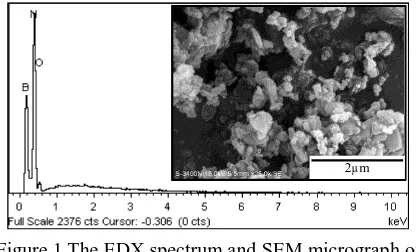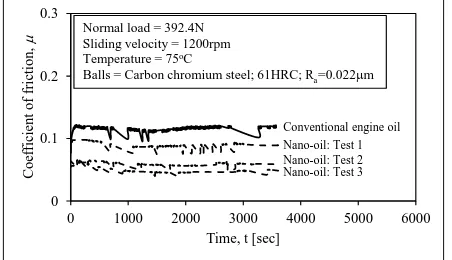International Forum on Front-line of Tribology in Asian Region
DRIVE TO GREENER FUTURE: TRIBOLOGICAL AND ENGINE PERFORMANCES OF NANO-OIL
Mohd Fadzli Bin Abdollaha,b,*, Muhammad Ilman Hakimi Chua Abdullahb, Hilmi Amiruddina,b, Noreffendy Tamaldina,b, Nur Rashid Mat Nuria,c
a
Centre for Advanced Research on Energy, Universiti Teknikal Malaysia Melaka
b
Faculty of Mechanical Engineering, Universiti Teknikal Malaysia Melaka
c
Faculty of Engineering Technology, Universiti Teknikal Malaysia Melaka Hang Tuah Jaya, 76100 Durian Tunggal, Melaka, MALAYSIA. Tel: + 606-234-6805, Fax: + 606-234-6884, *E-mail: [email protected]
Keywords: Wear, Friction, Nanoparticles, Engine oil, Engine Performance
ABSTRACT
This paper presents the experimental study on the tribological and engine performances of nano-oil. In this study, the nano-oil was prepared by dispersing an optimal composition (0.5 vol.%) of 70nm hexagonal boron nitride (hBN) nanoparticles in conventional diesel engine oil by sonication technique. The tribological study was performed using a four-ball tribometer, while the single cylinder diesel engine performance test was conducted using 20 hp, air cooled type, eddy current dynamometer. By comparing with conventional diesel engine oil, it was found that the nano-oil is effective in reducing the coefficient of friction and enhancing the engine performance, simultaneously reduces frictional wear on the contact surfaces of engine components. The results presented here may facilitate improvements in the energy efficiency of tribological systems towards a sustainable future for green technology advancement.
INTRODUCTION
With the increase in the number of vehicles, the problems with fuel consumption and environmental pollution are becoming more prominent. The use of an energy-conserving and emission-reducing automotive engine oil additive would have a great impact on energy conservation and environment protection. However, such an additive would need to enhance, or at least maintain the key lubrication properties. Thus, in this work, the potential of hBN nanoparticles as effective additive in conventional diesel engine oil, to enhance the tribological and engine performances, simultaneously reduce frictional wear on the contact surfaces was studied.
The uniqueness of this study exists in the fact that a low-cost and environmental friendly hBN nanoparticles is a solid lubricant that can sustain at high temperature applications and has excellent thermal conductivity properties. Thus, this can simultaneously improve tribological performance and boost heat transfer in engines, where high temperature is applied.
EXPERIMENTAL PROCEDURES
In this study, the nano-oil was prepared by dispersing 0.5 vol.% 70 nm hBN nanoparticles in conventional diesel engine oil, using an ultrasonic homogenizer for 20
minutes. The optimal design’s parameters were
determined from the previous work [1]. All samples were stabilized using a surfactant (oleic acid) to prevent sedimentation of nanoparticles. The surfactant has no significant effect on the tribological performance of lubricants [2].
Tribological testing was performed to determine the friction coefficient and wear rate between the contact surfaces using a four-ball tribometer. The ball diameter is 12.7mm and made from carbon chromium steel. The hardness, density and surface roughness (Ra) of the ball
are 61HRC, 7.79g/cm3 and 0.022µm, respectively. The testing procedure followed the standard of American Society for Testing and Materials (ASTM): D 4172-94 - Standard Test Method for Wear Preventive Characteristics of Lubricating Fluid (Four-Ball Method). All tests were run at the speed, load, time, and temperature of 1200rpm, 392.4N, 3600secs, and 75oC, respectively. The test was repeated three times to ensure the results are more precise and reliable.
The single cylinder diesel engine performance test was conducted using 20 hp eddy current dynamometer (air cooled type). The torque and power were recorded by DynoMite software.
In addition, the surface morphology was observed using Scanning Electron Microscopy (SEM) equipped with Energy-dispersive X-ray (EDX) spectrometer.
RESULTS AND DISCUSSION
Tribological Performance
The EDX spectrum and SEM micrograph of hBN nanoparticles is shown in Figure 1. The hBN nanoparticles were in spherical type, uniform and well dispersed.
2µm
International Forum on Front-line of Tribology in Asian Region
Figure 2 shows that the friction coefficient of the nano-oil decreased significantly by 25-50% for all three repeated tests, as compared with conventional diesel engine oil. To some extent, this suggests that hBN nanoparticles could play the role of ball bearings; where the sliding friction was changed into rolling friction between the friction pair, resulting in reducing the contact area between the frictional surfaces.
Besides, Figure 3 shows that the nano-oil reduced wear rate by approximately 58%, which is half of the total wear gained by conventional diesel engine oil. The wear debris collected from the used nano-oil is clearly found.
Thus, these results showed that the hBN nanoparticles could play well as promising friction modifier and anti-wear additive in conventional diesel engine oil.
0 0.1 0.2 0.3
0 1000 2000 3000 4000 5000 6000
C
oe
ffic
ient
of
f
ric
ti
on,
Time, t [sec] Normal load = 392.4N
Sliding velocity = 1200rpm Temperature = 75oC
Balls = Carbon chromium steel; 61HRC; Ra=0.022m
[image:2.595.308.539.192.266.2]Nano-oil: Test 3 Nano-oil: Test 2 Nano-oil: Test 1 Conventional engine oil
Figure 2 Friction coefficient of conventional diesel engine oil with and without 0.5 vol.% hBN nanoparticles
additive.
11.21
5.19
0.0 2.0 4.0 6.0 8.0 10.0 12.0 14.0
FTP
x
10
-8
Conventional engine oil
Ave
ra
g
e
we
ar
ra
te
[mm
3/s]
Nano-oil
Wear debris
10µm
Figure 3 Wear rates of ball materials lubricated under conventional diesel engine oil with and without 0.5 vol.% hBN nanoparticles additive. The right top image is
the SEM micrograph of wear debris found in used nano-oil.
Engine Performance
From Figure 4, both maximum power and torque of the engine improves approximately 6.05% at 3200 rpm, by using nano-oil, as compared with conventional diesel engine oil. This is in accordance with less frictional wear on the contact surfaces between the piston ring and
engine cylinder block, as shown in Figure 5. When the nano-oil was used in the test, the damage of the material due to adhesive wear type with intensive plastic deformation was less pronounced than for conventional diesel engine oil (Figure 5(c)). From the view point of boundary lubrication, these results may be due to the higher film thickness ratio, which is �nano-oil=0.1433 and
�conventional oil=0.0176.
0 2 4 6 8 10 12
1500 2000 2500 3000 3500
P
ower
,
P
[kW
]
Speed [rpm] Conventional
engine oil Nano-oil 6.5%
0 5 10 15 20 25 30 35
1500 2000 2500 3000 3500
T
or
que
,
T
[Nm]
Speed [rpm] Conventional
engine oil Nano-oil 6.5%
[image:2.595.60.286.304.434.2](a) (b)
Figure 4 Nano-oil effectively improves both maximum (a) power and (b) torque of a small diesel engine.
100µm 100µm
100µm
1mm 1mm 1mm
[image:2.595.310.538.309.442.2](a) (b) (c)
Figure 5 SEM micrograph of piston ring surfaces. (a) New piston ring, (b) lubricated using conventional diesel
engine oil and, (c) lubricated using nano-oil.
CONCLUSIONS
This paper presented results of experimental study on the tribological and engine performances of conventional diesel engine oil enriched with hBN nanoparticles additive. In summary, this study has contributed to our knowledge about the effectiveness of hBN nanoparticles to be both friction modifier and anti-wear additives in conventional diesel engine oil. In addition, the engine performance testing proved that this nano-oil effectively improves both maximum power and torque of the diesel engine as well as reduce wear of the engine components.
REFERENCES
[1]M.I.H.C. Abdullah, M.F.B. Abdollah, H. Amiruddin, N. Tamaldin, N.R. Mat Nuri, Optimization of tribological performance of hBN/Al2O3 nanoparticles
as engine oil additives, Procedia Engineering, (2014), DOI: 10.1016/j.proeng.2013.12.185.
[2]M.I.H.C. Abdullah, M.F.B. Abdollah, H. Amiruddin, N. Tamaldin, N.R. Mat Nuri, Effect of hBN/Al2O3
[image:2.595.59.285.483.621.2]
